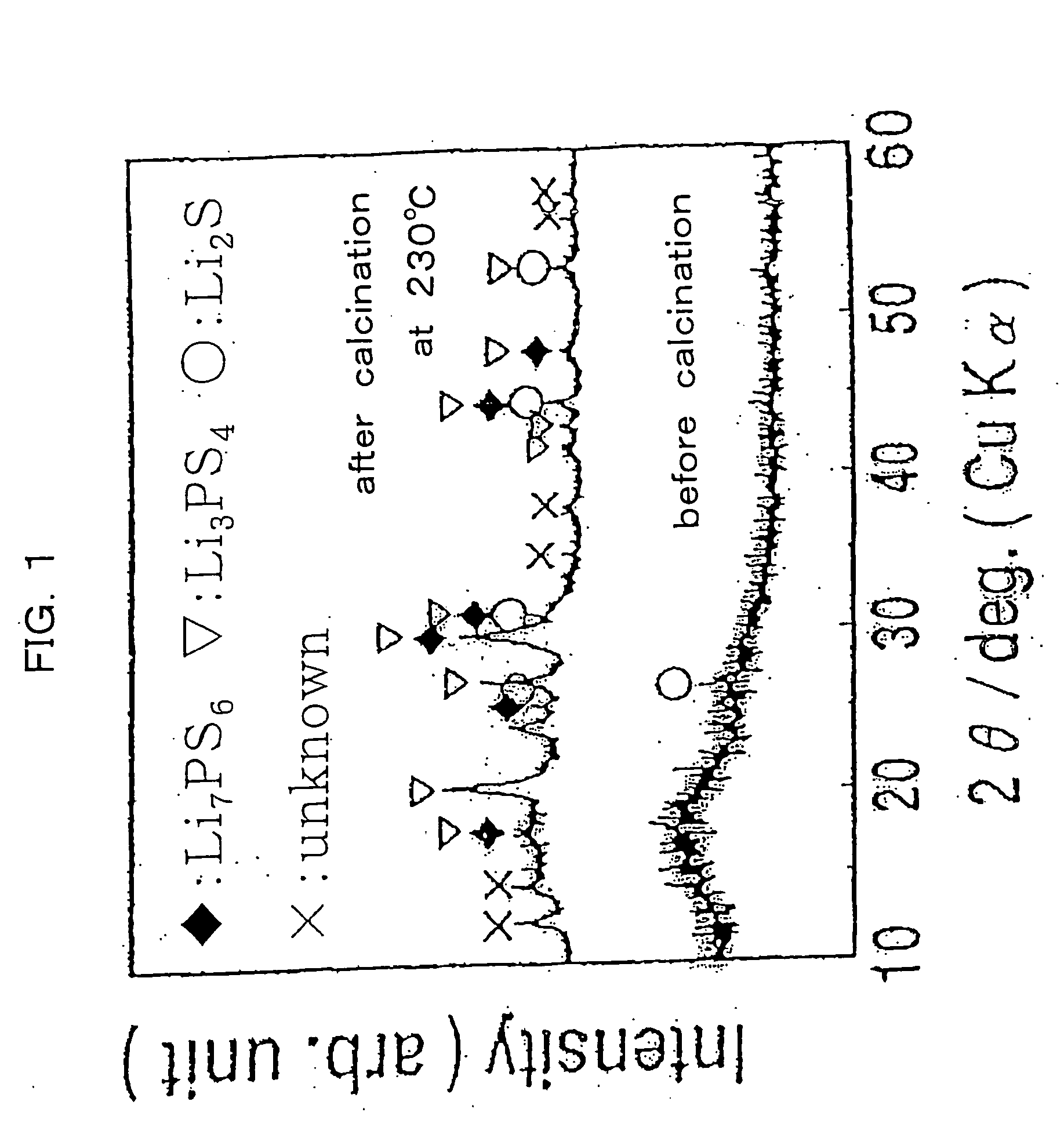Method for producing sulfide glass or sulfide glass ceramic capable of conducing lithium ion, and whole solid type cell using said glass ceramic
- Summary
- Abstract
- Description
- Claims
- Application Information
AI Technical Summary
Benefits of technology
Problems solved by technology
Method used
Image
Examples
example 1
[0051] Crystalline lithium sulfide, sulfur as a simple substance and phosphorus as a simple substance were used as starting raw materials. Powders of them were weighed in a dry box filled with nitrogen at a molar ratio of 1 / 1.25 / 0.5, and were charged together with aluminum-made balls into an aluminum-made pot to be used in a planetary type ball mill.
[0052] The pot was hermetically sealed completely in a state of nitrogen gas being filled therein.
[0053] By attaching the pot to the planetary type ball mill, initial stage milling was carried out for several minutes at a low rotational speed (the rotational speed being 85 rpm) for the purpose of sufficiently mixing the starting raw materials.
[0054] Thereafter by gradually increasing the rotational speed, mechanical milling was performed at 370 rpm for 20 hours.
[0055] As the result of X-ray diffraction for powdery sample thus obtained, it was made certain that the peaks of lithium sulfide (Li2S) and sulfur as a simple substance (S) c...
example 2
[0057] Metallic lithium in the form of small pieces, sulfur as a simple substance and phosphorus as a simple substance to be used as starting raw materials were weighed in a dry box filled in with nitrogen at a molar ration of 4 / 4.5 / 1.
[0058] Subsequently mechanical milling was performed in the same manner as in Example 1 except that the rotational speed in initial stage was made lower than that in Example 1 because of the metallic lithium in the form of small pieces being used, and then by gradually increasing the rotational speed, mechanical milling was performed at 370 rpm for 40 hours.
[0059] As the result of X-ray diffraction for powdery sample thus obtained, it was made certain that the peak of sulfur as a simple substance (S) completely disappeared, whereas vitrification thereof completely proceeded. The powdery sample was molded into pellet under increased pressure.
[0060] Thus a measurement was made of the electroconductivity of the resultant sample in the same manner as in...
example 3
[0062] The powdery sample which had been obtained in Example 1 was subjected to calcination at 230° C. in the presence of an inert gas (nitrogen).
[0063] After cooling the sample, a measurement was made of the electroconductivity of the resultant sample in the same manner as in Example 1. As a result it was an improved value of 4.1×10−4 S / cm at room temperature (25° C.). The X-ray diffraction patterns for the powdery sample before and after the calcination are illustrated in FIG. 1. It was made certain therefrom that sulfide crystals such as Li7PS6 and Li3PS4 were formed by carrying out the calcination.
PUM
| Property | Measurement | Unit |
|---|---|---|
| Temperature | aaaaa | aaaaa |
| Electric potential / voltage | aaaaa | aaaaa |
| Metallic bond | aaaaa | aaaaa |
Abstract
Description
Claims
Application Information
 Login to View More
Login to View More - R&D
- Intellectual Property
- Life Sciences
- Materials
- Tech Scout
- Unparalleled Data Quality
- Higher Quality Content
- 60% Fewer Hallucinations
Browse by: Latest US Patents, China's latest patents, Technical Efficacy Thesaurus, Application Domain, Technology Topic, Popular Technical Reports.
© 2025 PatSnap. All rights reserved.Legal|Privacy policy|Modern Slavery Act Transparency Statement|Sitemap|About US| Contact US: help@patsnap.com


